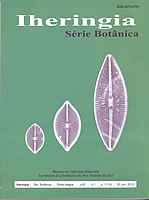A transferência de Navicula sovereignae Hustedt para o gênero Placoneis Mereschkowsky (Bacillariophyta)
Palavras-chave:
diatomácea, taxonomia, ultraestrutura, marismasResumo
As características morfológicas, métricas e estruturais de Navicula sovereignae foram estudadas em detalhes em amostras de sedimentos superfi ciais de marismas do estuário da laguna dos Patos, sul do Brasil (31°45’-32°12’S e 52°00’-52°15’W). A espécie apresenta valvas largamente elípticas, ápices subrostrados, sternum estreito com espessamento nodular na área central. As estrias são radiadas, areoladas, com comprimento irregular no centro da valva, formando uma área central subquadrangular. Ao microscópio eletrônico de varredura (MEV) observam-se em vista externa as fi ssuras polares e centrais da rafe curvadas em direções opostas. As helictoglossas são pequenas e salientes nas fi ssuras polares internas. As aréolas são arredondadas externamente e quadrangulares a retangulares internamente, características que permitem transferir Navicula sovereignae para o gênero Placoneis, sob a nova combinação Placoneis sovereignae (Hustedt) Torgan & Donadel comb. nov.
Downloads
Referências
ALFRED WEGENER INSTITUT. 2003. The Database. Disponível em: < http://diatomwebserver.awi.de/fmi/iwp/ cgi?-db=WebStart&-loadframes>. Acesso em: 10 de mar. 2010.
BRUDER, K.; MEDLIN, L. K. 2007. Molecular assessment of phylogenetic relationships in selected species/genera in the naviculoid diatoms (Bacillariophyta). I. The genus Placoneis Nova Hedwigia. v. 85, n. 3-4, p.
-352.
CORDAZZO, C.V.; SEELIGER, U. 1995. Guia ilustrado da vegetação costeira do extremo sul do Brasil. Rio Grande: Fundação Universidade de Rio Grande. 275p.
COX, E.J. 1987. Placoneis Mereschkowsky: the reevaluation of a diatom genus originally characterized by its chloroplast type. Diatom Research, v. 2, n. 2, p. 145-157.
______. 2003. Placoneis Mereschkowsky (Bacillariophyta) revisited: resolution of several typifi cation and nomenclatural problems, including the generitype. Botanical Journal of the Linnean Society, v. 141, p. 53-83.
______. 2004. Pore occlusions in raphid diatoms a reassessment of their structure and terminology. Diatom, v. 20, p. 33-46.
COX, E.J; ROSS, R. 1981. The striae of pennate diatoms. In: ROSS, R. (Ed.) INTERNATIONAL DIATOM SYMPOSIUM, 6., 1981, Koenigstein. Proceedings…Koenigstein: Otto Koeltz, 1981. p. 267-278.
COX, E.J; WILLIAMS, D.M. 2006. Systematics of naviculoid diatoms (Bacillariophyta): a preliminary analysis of protoplast and frustule characteres for family and order level classifi cation. Systematics Biodiversity, v. 4, n.4, p. 385-399.
FERNANDES, L. F.; SOUZA-MOSIMANN, R. M. de; FELÍCIO FERNANDES, G. 1990. Diatomáceas (Bacillariophyceae) do Rio Ratones, Florianópolis, Santa Catarina, Brasil: I – Baixo Curso e Estuário. Insula, n.
, p. 11-112.
HUSTEDT, F. 1955 Marine littoral diatom of Beaufort, North Carolina. Duke University Marine Station Bulletin, n. 6, p. 1-67.
______. 1966. Die Kieselalgen Deutschlands, Osterreichs und der Schweiz. Leipzig: Akademische Verlagsgesellschaft, 1966. 816p., (L Rabenhorst’s Kryptogamen-Flora von Deutschland, Bd. 7, Teil 3)
MANN, D.G. 1981. Sieves and fl aps: siliceous minutiae in the pores of raphid diatoms. In: ROSS, R. (Ed.) INTERNATIONAL DIATOM
SYMPOSIUM, 6., 1981., Koenigstein. Proceedings... Koenigstein: Otto Koeltz, 1981. p.279-300.
MARSHALL, H.G.;BURCHARDT, L.;LACOUTURE, R. 2005. A review of phytoplankton composition within Chesapeake Bay and its tidal estuaries. Journal of Plankton Research, v. 27, n. 11, p. 1083-1102.
MERESCHKOWSKY, C. 1903. Über Placoneis, ein neues Diatomeen-Genus. Botanishen Centralblatt, v.15, p.1-29. Beihefte
MOTA, F.S. 1951. Estudos do clima do Estado do Rio Grande do Sul segundo o Sistema de W. Koeppen. Revista Brasileira de Geografi a, v. 13, n. 2, p.107-116.
PATRICK, R.; REIMER, C. W. 1966. The Diatoms of the United States: exclusive of Alaska and Hawai. Philadelphia: Academy of Natural Sciences. 688p.
PROCOPIAK, L. K.; FERNANDES, L. F.; MOREIRAFILHO, H. 2006. Diatomáceas (Bacillariophyta) marinhas e estuarinas do Paraná, Sul do Brasil: lista de espécies com ênfase em espécies nocivas. Biota Neotropica, v. 6, n. 3, p. 1-28.
ROSA, Z.; CALLEGARO, V. L. 1988. Diatomáceas da Lagoa de Tramandaí e da Lagoa do Armazém, Rio Grande do Sul, Brasil: I – Gênero Navicula Bory. Iheringia. Série Botânica, n. 37, p. 17-32.
ROSS, R.; COX, E.J.; KARAYEVA, N.I.; MANN, D.G.; PADDOCK,T.B.B.; SIMONSEN, R.; SIMS, P.A. 1979. An amended terminology of the siliceous components of the diatom cell. Nova Hedwigia, v. 64, p. 513-533.
Beihefte.
SIMONSEN, R. 1974. The diatom plankton of the Indian Ocean Expedition of R/V “Meteor” 1964-1965. Meteor Forschungen Ergebnisse. Série D, v. 19, p. 1-107.
STOERMER, E.F.; KREISS, G. JR. 1978. Preliminary checklist os diatoms (Bacillariophyta) from the Laurentian Great Lakes. International ssociation for Great Lakes Research, v. 4, n. 2, p. 149-169.
VAN DER WERFF, A. 1955. A new method of concentrating and cleaning diatoms and others organisms. Verhandlungen der Internationalen Vereinigung der Limnologie, v. 55, p. 276-277.







